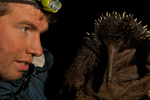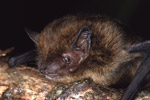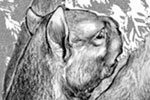
Tasmanian Tigers at Beaumaris Zoo, Hobart c 1918. Courtesy of the Tasmanian Museum and Art Gallery.
Man, not disease, drove the Tasmanian Tiger to extinction, according to a new study published in the Journal of Animal Ecology.
The Tasmanian Tiger or thylacine was a marsupial carnivore unique to the Australian island Tasmania that was last confirmed in the wild in 1933. The last individual died in Hobart zoo in 1936, although there have been sporadic claims of sightings since then.
While some have attributed the decline of the species to disease, the new study shows that the thylacine could have been wiped out by humans alone.
“Many people, however, believe that bounty hunting alone could not have driven the thylacine extinct and therefore claim that an unknown disease epidemic must have been responsible,” said University of Adelaide professor Thomas Prowse, lead author of the study. “We tested this claim by developing a ‘metamodel’ – a network of linked species models – that evaluated whether the combined impacts of Europeans could have exterminated the thylacine, without any disease.”
“The new model simulated the directs effects of bounty hunting and habitat loss and, importantly, also considered the indirect effects of a reduction in the thylacine’s prey (kangaroos and wallabies) due to human harvesting and competition from millions of introduced sheep,” Prowse continued. “We found we could simulate the thylacine extinction, including the observed rapid population crash after 1905, without the need to invoke a mystery disease. We showed that the negative impacts of European settlement were powerful enough that, even without any disease epidemic, the species couldn’t escape extinction.”
Most of Australia’s largest animals have been driven to extinction by humans. Today, the continent’s biodiversity is just a fragment of what existed just prior to human contact.
Prowse et al (2013). No need for disease: testing extinction hypotheses for the thylacine using multi-species metamodels. Journal of Animal Ecology DOI: 10.1111/1365-2656.12029
Related articles
Scientists: bizarre mammal could still roam Australia

(01/03/2013) The continent of Australia is home to a wide variety of wonderfully weird mammals—kangaroos, wombats, and koalas among many others. But the re-discovery of a specimen over a hundred years old raises new hopes that Australia could harbor another wonderful mammal. Examining museum specimens collected in western Australia in 1901, contemporary mammalogist Kristofer Helgen discovered a western long-beaked echidna (Zaglossus bruijnii). The surprise: long-beaked echidnas were supposed to have gone extinct in Australia thousands of years ago.
Island bat goes extinct after Australian officials hesitate

(05/23/2012) Nights on Christmas Island in the Indian Ocean will never again be the same. The last echolocation call of a tiny bat native to the island, the Christmas Island pipistrelle (Pipistrellus murrayi), was recorded on August 26th 2009, and since then there has been only silence. Perhaps even more alarming is that nothing was done to save the species. According to a new paper in Conservation Letters the bat was lost to extinction while Australian government officials equivocated and delayed action even though they were warned repeatedly that the situation was dire. The Christmas Island pipistrelle is the first mammal to be confirmed extinct in Australia in 50 years.
Humans killed off magnificent Australian megafauna, flipping rainforest into savannah

(03/27/2012) The theory that humans, and not climate change, was primarily responsible for the extinction of giant marsupials in prehistoric Australia takes another step forward with a new study in Science. Exploring sediment cores for past evidence of big herbivores, researchers found that the arrival of humans coincided with the loss of a menagerie of magnificent beasts, from giant kangaroos to fearsome marsupial lions and monster birds to Komodo dragon-like reptiles. The decline of this megafauna ultimately led to ecological changes that may have caused Australia’s rainforest to become savannah.
Back from extinction: Tasmanian tiger caught on video?
(11/16/2010) A 9 second video released today on YouTube claims to show a living Tasmanian tiger. The footage was captured by Murray McAllister last year. McAllister says he has seen the believed-to-be-extinct Tasmanian tiger several times in the last few years.
New study: overhunting by humans killed off Australia’s megafauna
(01/21/2010) For over a century and a half researchers have debated whether humans or climate change killed off Australia’s megafuana. A new paper in Science argues with new evidence that Australia’s giant marsupials, monstrous reptiles, and large flightless birds were brought to extinction not by an unruly climate, but by the arrival of humans.
Extinct since 1963, wild eastern quolls discovered in Australia
(10/16/2008) Two eastern quoll have been found as roadkill on the Australian mainland. Although considered extinct in Australia since 1963, these carnivorous marsupials remain abundant on the island of Tasmania.
Humans – not climate – drove extinction of giant Tasmanian animals
(08/11/2008) Humans — not climate change — were responsible for the mass extinction of Australia’s megafauna, according to a new study published this week in the journal Proceedings of the National Academy of Sciences.
Did Tasmanian Tiger survive extinction until 1950s?
(06/27/2007) A University of Adelaide project led by zoologist Dr Jeremy Austin is investigating whether the world-fabled Tasmanian Tiger may have survived beyond its reported extinction in the late 1930s.